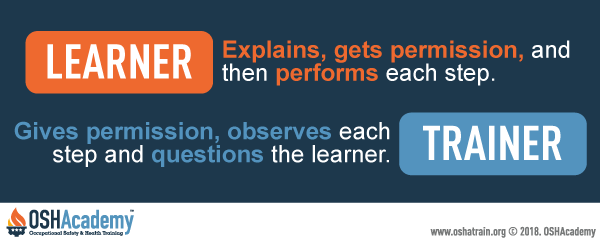The 7-Step OJT Process
Step 4: Student Tells, Asks, and Shows
At this point in the training, the student takes a more active role by performing the actual steps of the procedure.
However, this doesn't mean the student is left alone to figure things out. The trainer stays close, watching and guiding each move. This step marks the first time the student carries out the procedure, so it must be done carefully, one step at a time, under direct supervision.
The student begins by telling the trainer what they plan to do. This explanation gives the trainer a chance to check for understanding before the student performs the task. Next, the student asks for permission to go ahead. Only after receiving a clear "yes" from the trainer should the student perform the step. This process is repeated for each part of the procedure, no matter how simple it may seem.
- The student explains what they will do for the current step.
- The student asks the trainer for permission to proceed.
- The trainer either approves or corrects the student before giving permission.
- Once permission is granted, the student performs the step while the trainer watches closely.
This method is especially important for tasks that involve any risk of injury. Since the student is not yet fully qualified, OSHA requires very close, direct supervision when there is any chance of harm. For example, if the training involves operating a forklift, the student should first simulate the controls in a safe area or with the machine turned off before doing anything live. The same goes for lockout/tagout procedures, electrical work, or using sharp tools—these should be practiced in controlled environments whenever possible.
This step-by-step approach serves two purposes. First, it helps protect the student by ensuring nothing is done without the trainer's oversight. Second, it builds confidence. As the student hears themselves explain the process, gets permission, and then physically carries out each action, they begin to reinforce their learning. The trainer remains alert during this entire time, ready to step in, correct mistakes, or pause the activity if anything seems unsafe.
By the end of this stage, the student not only practices the procedure but also learns how to communicate clearly and act responsibly during tasks. It teaches safety, awareness, and attention to detail—all skills that matter just as much as technical ability on the job.
Knowledge Check Choose the best answer for the question.
6-6. What must the student do to help stay protected from getting hurt while being trained?
You forgot to answer the question!

